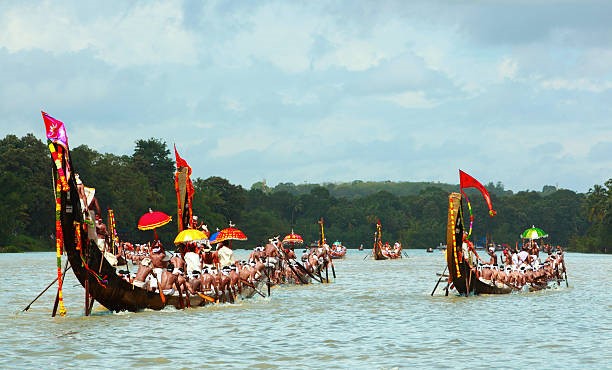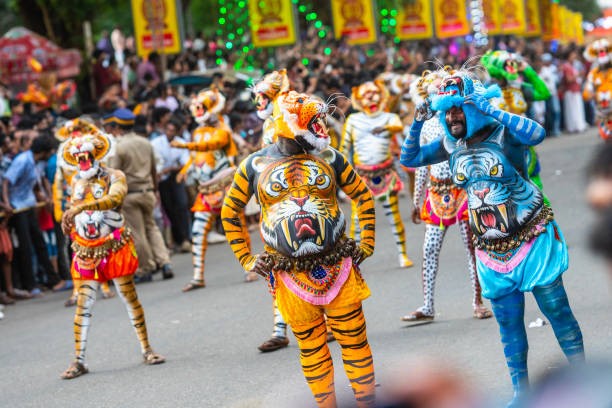All About Onam: the History, the Myths, and the Celebrations
September 02 , 2024

Between August and September every year, the State of Kerala gets ready to celebrate Onam. While it has its roots in Hindu mythology and as a harvest festival celebration, it is a festival celebrated by all Malayalis – not just in Kerala but across the world.
As with many cultural festivals, there are multiple explanations for the origins of the festival. The most fascinating and the one recounted by Malayalis worldwide is that of the great king Mahabali, his banishment to the underworld, and his yearly returns to Kerala, where his great kingdom once resided. It is also a festival with a diverse plethora of activities, expressions, and traditions surrounding it.
Let us enlighten you briefly on the mythology and the various cultural aspects of this joyous festival!
Mahabali’s Annual Return to Kerala from the Netherworld
For most Malayalis, Onam commemorates King Mahabali’s return to Kerala from The Underworld. He was a wise and benevolent king who ruled without discrimination and brought the Malayali people of old to prosperity. Vishnu sought to test his devotion to the gods, so he reincarnated himself as the dwarf, Vamana, approached Mahabali, and asked him for "three steps of land"; the King acquiesced.
Vamana, then, grew in size to a gigantic form, amassing the entirety of Earth with his first step and the whole heaven with his second. Lord Vishnu, finally revealing himself, asked Mahabali where else he could place his final step. The King happily offered his head, as a demonstration of his utter faithfulness and devotion to Lord Vishnu.
With his final step, Vishnu banished Mahabali to The Underworld, or Patalam in Malayalam. However, recognizing the devout and selfless nature of the King, Lord Vishnu granted him permission to return to his kingdom to be amongst his people, once every year. Onam, more specifically the tenth day of Onam, celebrates his return.
If you are wondering what we meant by the phrase “tenth day of Onam”, do not fret; we shall explain all ten days and their significance —very briefly— for you.
The Ten Days of Onam
Atham
This is when both Mahabli and the people of Kerala prepare for his return to Onam. Pookalams –floral carpets— are designed and put up outside people’s homes: they follow a specific pattern, increasing in size and complexity as the Tenth Day approaches. The middle of the pookalam is completed during Atham, representing Mahabali’s iconic yellow clothing.
Chithira
During Chithira, people will start cleaning their rooms, houses, and surroundings. The pookalams, of course, take on another layer.
Chodi
Many will shop for jewelry, clothes, and gifts in preparation for the coming days.
Vishakam
Vishakam is when things start to really ramp up. It marks the beginning of several competitions across the state for celebrating athleticism, artistic performances, and pookalam designs.
Anizham
The Vallamkali Boat Races begin on this day. These boats are long and snake-shaped, rowed by hundreds of boatmen per boat and witnessed by thousands of spectators.
Thriketta
People living in different cities from their families will have begun to go back home and many businesses will have shut down as the Onam holidays begin.
Moolam
Kerala would have been beautifully decorated by this time, with houses adorned with flowers, swings, and pookalams. This is when several events featuring Onam dances also start to pop up.
Pooradam
Clay pyramids of Mahabali (Onathappan) will be placed at homes. The pookalams should have eight rings by now.
Uthradom
On the evening of Uthradom is when Mahabali leaves the Underworld and arrives in his kingdom. Many will have completed their shopping of fruits and vegetables to prepare the customary sadya for the next day, a traditional lunch, ubiquitous with Onam, eaten on a banana leaf comprising around twenty-six to twenty-eight dishes.
Thiruvonam
The tenth and main day of Onam celebrations and when King Mahabali is said to grace people’s homes with his presence. The completed pookalams are on display, people aredressed in beautiful clothing, the sadya is enjoyed, games are played, and gifts are distributed.
The community enjoy each other’s company in blissful harmony.
If you are curious at all about what constitutes a sadya, the Onam games, the traditional clothes, and other components of the festival, the next section is for you!
The Many Activities and Festivities of Onam
Pookalam

Pookalam, similar to rangolis, are complex and beautiful patterns created using flowers, built layer upon layer over ten days. While most follow a set pattern consisting of ten rings of contrasting colors, some include grander designs, like images of Mahabali, company logos, and more.
Vallamkali Boat Races
Vallam kali, literally translating to boat game, is a traditional canoe race in Kerala, using paddled war canoes and featuring many kinds of long boats – or ‘snake’ boats.
The iconic design of the boats are said to be created when a famous carpenter was tasked with creating a war boat during the early 13th-century war between the kingdoms of Kayamkulam and Chembakassery.
Onathallu
Onathallu, or Onam Fight, features both choreographed martial dances and proper fights, and is a highlight of Onam. It has its roots in Kalari Fight, the traditional martials arts form having roots in South India.
Amongst the participants, the left hand is usually used to block, while the right is used to strike.
Pulikali

Pulikali features street performers that dance to the rhythm of traditional instruments while covered in body paint depicting tigers or leopards. The dancers, who typically use masks, imitate tigers and leopards while receiving encouragement from spectators.
Onam Sadya
An Onam Sadya lunch typically consists of variety of Malayali vegetarian dishes and is served on a banana leaf.
It is served with rice and an assortment of curries, snacks, pickles, and papadam – an all-in-one course designed to fill anyone’s stomach. It ends with payasam, served on the banana leaf, as dessert: a sweet pudding that goes very well with bananas and papadams. People are usually seated cross-legged on mats, laid out on the floor; there is no cutlery as the food is eaten with the right hand, with the fingers cupped to form a ladle.
Onamkali
OnamKali, or Onam Games, collectively refer to the games played during Onam festival, such as tug-of-war, archery, and sack race. Swings also play a significant role in Onam celebrations, particularly in Kerala's rural and village communities. You can find young couples and kids frequently rocking each other on swings and singing Onam songs (Onapattu).
Elephant Processions
An incredibly anticipated Onam activity where elephants, adorned with jewels, flowers, and other decorations, parade around, shimmy, and mingle with onlookers.
Folk Dances
Onam features an array of folk dances, unique to Kerala. Women execute the clap dance known as kaikottikali, in which they honor King Mahabali and also dance around a lamp, called Thiruvathira Kali. Kummattikali is a vibrant mask dance in which performers move from house to house wearing masks. The most well-known folk dance, called Kathakali, is performed by dancers dressed in green face paint, portraying well-known myths and folktales.
Onam’s Significance to Malayalis
Onam is celebrated with great enthusiasm by Malayalis worldwide, marking a time of unity and harmony as people from all walks of life exchange greetings, feed each other sadya, and partake in traditional activities. This season fosters community bonding, offering Malayalis dispersed across cities, states, and countries a chance to reunite with their families and strengthen social ties. For many living abroad, Onam serves as a precious opportunity to reconnect with Kerala's rich cultural heritage through traditional art forms, music, and dance. As a celebration tied to the harvest season, it also expresses gratitude for agricultural abundance and showcases the bounty of Kerala’s crops. The grand Onam Sadya, or feast, not only allows for sharing traditional dishes but also supports local economies through increased business for restaurants and caterers. Ultimately, Onam connects Malayalis to their roots, celebrating their shared history and cultural diversity while promoting generosity, inclusiveness, and respect.
Conclusion
The Onam season is an incredible opportunity to come visit Kerala and partake in all the activities and festivities the State and the festival has to offer. The sadya, especially, is not something to be missed, offering delicious food and the most splendid desserts. If finding a family to host you proves to be difficult, accommodations around Kerala offer activities and food tailored for the complete Onam experience.
Follow Us On
Drop your Queries
Categories
Adventure and Outdoor Activities
Attractions / Destination Guides
Culture and Cuisine
Travel Tips and Advice
Resort Facilities
Wellness and Ayurveda
Seasonal Highlights
Recent Post
Tags












